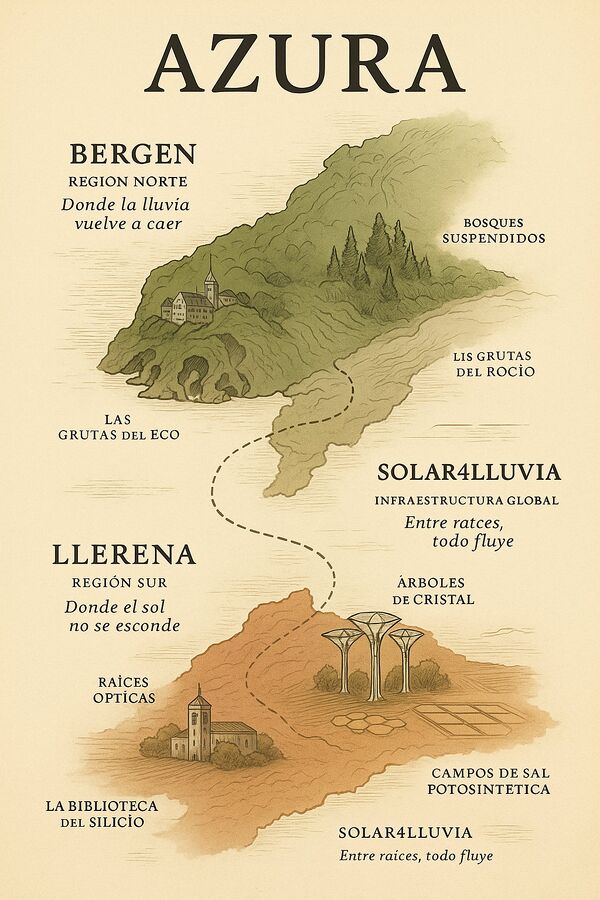A short solarpunk novel in the spirit of Ursula K. Le Guin
Solar4Rain
A short solarpunk novel in the spirit of Ursula K. Le Guin
In Azura, sky and soil are not opposed. They lean toward each other, like old lovers who once hurt each other.
I. The Seasons of the Network
There were no seasons in Azura, not in the way the old world had them. No winters or autumns, not even summers: only light and its absence; moisture and its absence; heat, and the memory of its passing.
In the North, it now rained. Real rain, not the recycled dew of the condensers, but water from the sky. No one quite knew why—perhaps the atmosphere, humiliated for centuries, was beginning to forgive them—but the clouds had returned. And with them, shadow.
The South, still dry, still radiant, looked on with a mixture of pride and fear. For generations, they had been the solar heart of the Solar4Rain Network: harvesters of energy, vapor condensers, weavers of water from nothing. Now, with the North overflowing, the flow reversed: water descended, light ascended.
The ancients would have called it a miracle. The engineers called it a system adjustment. The elders of the South called it exchange. But some whispered a forgotten word: Dependence.
II. The Agreement
Amiya was no longer a child. She had completed twenty-six solar cycles, though not all were measured the same between regions. The North still considered her young. The South, which grew hard and early, called her an old woman.
She had been given a task that seemed simple: to supervise the redistribution of flows between Primary Trees of the South and Hydraulic Towers of the North. But the mission carried a deeper weight: to ensure that exchange did not become dominion.
There were those who said the North had begun to demand light too regularly. That their rain-fed crops expanded beyond what was necessary. That, instead of being grateful for the South's solar energy, they accounted for it.
The language had changed. They used to speak of "sharing." Now they spoke of "flow balance."
A technologist from the North, a wiry man named Keiran, said it plainly while they examined the optical root of a transmission tower:
"This cannot go on indefinitely. The Network needs structure. Hierarchy. It cannot be sustained on solar idealism."
Amiya looked at him with a mix of pity and recognition.
"The water you drink does not fall in columns. Yet it flows."
Keiran said nothing.
III. The Fallen Tree
A Crystal Tree fell in the South. Not from technical failure, but from sabotage. No one said it aloud, but the sensors were clear: intentional filament cuts and disrupted flow. The roots showed no mechanical stress, only human interference.
There was no trial. Only a meeting.
The Solar Council, from both North and South, sat in a circle. There were no cameras or minutes. Only words.
"What do we do when the network becomes a trap?" asked an old woman from the South.
"Or when exchange becomes an imposition?" added a young man from the North, his voice trembling.
Amiya didn’t speak until the end. When she did, she spoke slowly, like one carving a seed into stone:
"A fallen Tree is more than a loss. It is a warning. We were not wrong to connect roots. But we erred in forgetting that every root, when it cannot breathe, rots."
IV. Epilogue: The Deep Light
No one ever knew who sabotaged the Tree. Perhaps it was many. Perhaps no one. Perhaps it was the system itself, a natural self-regulator responding to accumulated tension.
What followed was not rupture, but realignment. The flows were adjusted. Usage was reduced. Slowness was cultivated. The Network grew no more. It folded inward, like a flower that learns to close at night, not out of fear, but out of wisdom.
Amiya returned to the South, not as a technician, but as a caretaker. She planted a new Tree where the fallen one had stood, without a name, without a number. Just a Tree. A root of light that expected no gratitude, no calculation, no destiny.
Only exchange.
